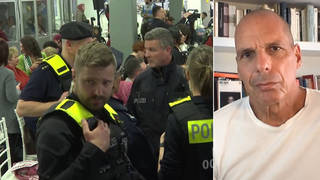
Related
Taser International–the maker of Taser electro-shock weapons–announced this month that they will begin a major campaign to market a new model of the weapon to consumers. We speak with the head of Amnesty International, which issued a new report on Taser, as well as a lawyer representing the family of a man killed by police with a Taser gun in January 2005. [includes rush transcript]
Earlier this month, Taser International — the maker of Taser electro-shock weapons, announced that they will begin a major campaign to market a new model of the weapon to consumers.
Currently, 95% of Taser’s weapons are sold to law enforcement agencies in the U.S.
Tasers are shaped like handguns and administer a 50,000-volt shock by shooting someone from a distance, or by applying the weapon directly to the skin.
Taser made this announcement despite growing concerns over the safety and use of the weapons by police forces around the country. The weapon has become increasingly popular in police agencies who claim that lives are saved by using a Taser rather than a firearm.
Taser International declined our request for an interview — but this is what Orange County Florida Sheriff–Kevin Beary–had to say about his department’s use of Tasers at a conference sponsored by the company in Orlando in 2003.
- Sheriff Kevin Beary, of Orange County Florida.
Yesterday, the Orange County Sheriff’s Department told Democracy Now that they are reviewing their policy on the use of Taser weapons. Amnesty International has documented more than 80 Taser-related deaths since 1999 — 60% of which occurred in the last year. Amnesty has called for a suspension of the use of the Taser until it can be determined if they are killing people.
In an Amnesty Report titled– “Excessive and Lethal Force?: Deaths and Ill-treatment Involving Police Use of Tasers”–the human rights organization concluded that–“far from being used to avoid lethal force, many US police agencies are deploying Tasers as a routine force option to subdue non-compliant or disturbed individuals who do not pose a serious danger to themselves or others.
They have been used against unruly school children–mentally disturbed or intoxicated individuals–unarmed suspects fleeing minor crime scenes–and people who fail to comply immediately with a command.”
- William Schultz, Executive Director, Amnesty International USA.
- John Burris, Civil Rights Attorney representing the family of Greg Saulsbury killed by police with Taser gun in January of this year in Pacifica California. Burris is also looking into representing families of 2 other victims killed by Tasers.
Transcript
JUAN GONZALEZ: Taser International declined our request for an interview. But this is what Orange County Florida Sheriff Kevin Beary had to say about his department’s use of tasers at a conference sponsored by the company in Orlando in 2003.
SHERIFF KEVIN BEARY: I can tell you that the Orange County Sheriff’s office in the late 2000 had six testing evaluation tasers. Since then, we bought 500 more tasers. And if things look good at the end of the year budget, we’re going to go to full implementation. Now I’ll also tell you that since we’ve put the tasers on the street, we’ve dropped our injuries to deputies by 80%. And, folks, for the administrators in this room or the training people, you need to go back and make sure that this tool is properly placed in your use of force makers. Don’t put it out there all the way to deadly force or you won’t get the results. You need to put it in “when that sucker wants to fight, it’s time to put him down.” We went from 13 uses of firearms situations in the year 2000 to four in 2001 and I went 15 months without a shooting, and let me make one thing perfectly clear. The taser is fabulous, absolutely a great tool.
AMY GOODMAN: Yes, Orange County Florida Sheriff Kevin Beary speaking in 2003. On Thursday, the Orange County Sheriff’s Department told Democracy Now!, they’re reviewing their policy on the use of taser weapons. Amnesty International has documented more than 80 taser-related deaths since 1999, 60% of which occurred in the last year. Amnesty has called for a suspension of the use of taser until it can be determined if they’re killing people. In an Amnesty report entitled “Excessive and Lethal Force?: Deaths and Ill-treatment Involving Police Use of Tasers,” the human rights group concluded that, “far from being used to avoid lethal force, many U.S. police agencies are deploying tasers as a routine force option to subdue noncompliant or disturbed individuals who don’t pose a serious danger to themselves or others. They have been used against unruly school children, mentally disturbed or intoxicated individuals, unarmed suspects fleeing minor crime scenes and people who fail to comply immediately with a command.” We’re joined now by the executive director of Amnesty International, William Schultz. Welcome to Democracy Now!
WILLIAM SCHULTZ: Pleasure to be with you.
AMY GOODMAN: Well, can you talk about this report?
WILLIAM SCHULTZ: Amnesty International does not oppose tasers across the board. There may well be circumstances where police should use tasers instead of using handguns or wooden batons. The problem is that police has been convinced by Taser International that these are non-lethal weapons. The result is that the police are using them far too frequently in situations that they would never have used lethal weapons in before, against 6-year-old school children, against 71-year-old grandmothers. They are using them far too frequently, and these weapons may well be killing people. They may well not be lethal. Just this past week —
AMY GOODMAN: They may be lethal?
WILLIAM SCHULTZ: They may well be lethal. Just this past week, the Summit County medical examiner in Ohio linked tasers to the death of an individual who had been tased three times by the Akron police. Taser International says there is no connection. It says, these people would have died anyway. But we have at least 12 medical examiners or pathologists saying, we think there may well be a question. And all that Amnesty is saying is very simple: Let’s find out. Let’s have an independent medical examination systematically determine whether these are dangerous weapons or not, and if they are dangerous, then let’s have the police adopt appropriate protocols, guidelines, and restrictions for their use.
JUAN GONZALEZ: Now your report documents cases where people, who were subjected to a taser, to being shot with tasers, ended up dying. But do you touch on the issue that some police forces raise, that the use of tasers has lead to a reduction of the amount of lethal force used, in other words, firearms being shot at individuals? Although, I know it is hard to compare but has there been a significant reduction in the use of lethal methods by police?
WILLIAM SCHULTZ: Well, I think until we know whether indeed tasers are also a lethal weapon, it is hard to tell the answer to that question. What we know for sure is that a police department that might have its officers drawing their guns out of their holsters, their handguns six times a month may well now be tasing someone 1,000 times a month. Now if tasers are in fact designed to be non-lethal alternatives to the use of force, why is it that time and again we are seeing tasers used in circumstances that police would never have used handguns or wooden batons?
AMY GOODMAN: You —
JUAN GONZALEZ: I’m sorry.
AMY GOODMAN: Go ahead.
JUAN GONZALEZ: In terms of this whole issue of now tasers being marketed to the public in general, and for $1,000 a piece, what are the restrictions that already exist on the books in various states on this?
WILLIAM SCHULTZ: Well, in most states, there are virtually no restrictions. It is true that in some states, if you buy a taser from a gun shop, you have to go through a background check. On the other hand, you can buy an M-18 taser off the internet without any kind of background check whatsoever. And so we face a situation where absolutely anyone can buy a taser without training, without having to be forced to go through any kind of restrictive regimen at all. They can use them against their children, we’ve seen this happening already, use them against their spouses, against their elderly parents, against the police. And this is one reason that Amnesty joins with most police departments in calling for the absolute ban on sale of tasers to civilians.
AMY GOODMAN: Can you explain what tasers and stun guns are and how they’re alike and how they’re different?
WILLIAM SCHULTZ: Well, a taser is a weapon that fires a dart that is attached to a wire from the gun to the victim, to the subject, and the prongs of the arrow, of the end of the taser, embed themselves in the body of the victim, such that an electric shock of up to 50,000 volts is sustained. For the police version, it is a five-second shock, but it can be repeated any number of times. And I might say parenthetically that many of the deaths we’ve seen are with the repeated use of tasers. The civilian versions are a little different. They inflict a 10-second shock. When you repeat it, you can shock for up to 30 seconds with a civilian version of tasers. It is even, in that sense, a tougher weapon than the police weapon. Stun guns are — don’t have this connecting wire. They often have to be applied directly to the body and, therefore, can’t be applied at a distance.
AMY GOODMAN: What about this campaign? And I’m sorry Taser [International] didn’t join us or offer up a representative but what about Taser’s campaign now to push tasers to civilians, to consumers?
WILLIAM SCHULTZ: Well, I personally and Amnesty International finds that outrageous. As I say, there may well be some circumstances under which for the police it is a very appropriate alternative to the use of a handgun. Obviously Amnesty would rather see someone taken down through an electric shock that doesn’t do any harm than through a gun that can kill the person, of course that’s true. That’s common sense. But Taser is clearly misrepresenting the nature of its weapon and it is now trying to propagate this weapon throughout the population. I think we have enough child abuse and spousal abuse and attacks on the police without giving the public still one more weapon.
JUAN GONZALEZ: We’re also joined on the phone by John Burris, who is a civil rights attorney representing the family of Greg Saulsbury, killed by police with taser guns in January of this year in Pacifica, California. Burress is also looking into representing families of two other victims killed by tasers. Welcome to Democracy Now!
JOHN BURRIS: Yeah. Good morning.
JUAN GONZALEZ: Could you tell us the circumstances of your client’s death as a result of a taser shooting?
JOHN BURRIS: Yes. Gregory Saulsbury, African American male, 30 years old, was at home with his family. He was acting bizarre, to say the least. The family was very concerned about his mental and emotional welfare. He was being sort of contained within a family room when the father of Gregory Saulsbury asked the family to call the paramedics, specifically to call paramedics so that he can get some medical treatment. Within about three to five minutes, the police arrived at the door without the paramedics. The family advised the police that they did not need their assistance, they needed paramedics. The police basically said we’re going to handle this first and young Gregory looked up, saw the police. When he stood up and when he did that, the police bum rushed him, if you will, attacked him, jumped on top of him. Three or four officers and they immediately began to taser him and repeatedly tased him for a period of time. The father was saying to them, what are you doing? The young man was essentially saying, dad, they’re killing me, they’re killing me. He was responding to the electrical shock. The police ultimately removed the father from the room and the young man died there in the room. He had been repeatedly shot multiple times by the taser. So, we have since then, of course, looked at this whole case. I think one of the issues that’s been raised is, there is this argument that the person would have died anyway. You know, when I look at that and I hear that, I have two other cases I’ve looked at, you will find basically healthy young people, people with no previous history of heart conditions, they are either under the influence of drugs or they’re very excited, they’ve been running, etc. And it raises a real question about if you know that’s the case and you are giving people electrical shock when they are in an excited situation, whether or not you should do that at all. Now we’ve had a second autopsy performed on Mr. Saulsbury, the results have not come back. We certainly do not believe that this 30-year-old African American male, who otherwise is in good health, would have died, notwithstanding anything if the tasing had not been done. Our view is that the taser was inappropriately used; he was repeatedly shocked. He was unarmed, essentially it was an enclosed situation. He had no weapon, he didn’t have a t-shirt on and there were no circumstances where deadly force would have been used at all and thus it should not have been used. There were a lot of other ways to approach this but I think that the issue that we’re seeing with the taser is that it is being used unnecessarily, under circumstances to take care of every condition and even if no deadly force would have been used, even if batons wouldn’t have been used, they are essentially being substituted as a way to take care of every situation regardless of whether or not force was warranted or not.
AMY GOODMAN: John Burris, civil rights attorney and William Schultz, executive director of Amnesty International. We’ll be right back in a minute.
[break]
AMY GOODMAN: Our guests are William Schultz, the executive director of Amnesty International. We’re also joined on the phone by John Burris, who is representing the family of a man killed after a taser gun was used on him by police. William Schultz, is Amnesty calling for a moratorium on or a ban on the police use of stun guns and tasers, in particular?
WILLIAM SCHULTZ: We’re calling for a moratorium on the police use of tasers until those systemic, independent medical tests have been undertaken and we know what kind of restriction or protocols ought to be adopted by the police.
JUAN GONZALEZ: Taser, of course, is the firm that got quite a bit of attention a few months ago when Bernard Kerik was nominated by President Bush to be head of Homeland Security. He was on the board of Taser.
WILLIAM SCHULTZ: Yes, that’s right.
JUAN GONZALEZ: And apparently he and several other executives of the members of the board of directors all sold their shares, their options in Taser just before The New York Times article was about to come out that would document some of these problems and the company stock has since had a major hit as a result of all of these allegations. Your sense of this situation, the situation of the company itself right now?
WILLIAM SCHULTZ: Well, I’m really not qualified to comment on the economic health of the company. Of course, Amnesty’s interests here have nothing to do with whether Taser prospers or not. Ours are solely human rights related. I will say that I think that the more deaths that occur in propinquity to the time when a taser was used on a subject, the more that happens, the more lawsuits you are going to see, the more reticence you are going to see, as we already are, on the part of police departments and city councils around this country to adopt tasers. That’s why I think it behooves Taser International to join us in calling for independent tests, by something like the institutes of health, for example, or an independent research institute connected with the university’s medical school. Because I think we all need to know the truth.
JUAN GONZALEZ: To your knowledge, are there any other countries that use tasers for their local law enforcement?
WILLIAM SCHULTZ: Well, certainly stun guns are widely used around the world. In fact, stun guns are one of the most common instruments of torture, and Amnesty has regularly documented their use in many, many countries for the purposes of torture, and other police departments in different parts of world do use stun guns to the extent to which Taser International has exported tasers. I think we need to ask them.
AMY GOODMAN: John Burris, you wanted to comment?
JOHN BURRIS: I just want to say that there is a growing body of medical knowledge out here that really has raised real questions about the impact that the taser has on one’s heart. A cardiologist here in the University of California, San Francisco, was very clear that under certain circumstances, you can clearly initiate a cardiac arrhythmia in a person who was otherwise healthy, given the amount and the number of times it that a taser has been issued, and I think that that is going more and more. We’re seeing more in terms of pathologists. And if you — the important part for me as a civil rights lawyer is the city and the municipalities who are using this, are they being placed on notice? And notwithstanding what Taser is doing, municipalities ought to take another look because they are now being placed on notice. The more these deaths occur and the more they’re being employed without clear guidelines, not only to the officers themselves, and some kind of protocol to set forth, the cities themselves and police agencies are really setting themselves up for major damages, notwithstanding what Taser does because they now have to go back to Taser and should say to Taser, you have told us these things are proper, but what about these kinds of conditions where people are dying, and what do you say about that? And tell us how this particular weapon does not create this increased risk of harm and potential death to the various people under certain kind of conditions? Until that happens, I think we’re going to have a flood of lawsuits, and it’s going to endanger many more cities than otherwise should be based upon this propaganda campaign that has been — and these sort of goods they’ve been sold by Taser.
JUAN GONZALEZ: Finally, I’d like to ask William Schultz, in your study of the various taser incidents, did you notice any racial or ethnic disparities in the use of the taser weapon by these police departments or is it just generally across the board excessive use?
WILLIAM SCHULTZ: It’s — taser is an equal opportunity inflictor of suffering.
AMY GOODMAN: And children. Talking about a handcuffed 9-year-old girl in Arizona who was tasered. A 6-year-old mentally disturbed boy in Florida?
WILLIAM SCHULTZ: That’s right. We tracked a number of cases where one cannot imagine that had the police been faced with this problem, with a 6-year-old, 9-year-old, 71-year-old grandmother, that they would have drawn their guns and shot the person. If they had, there would have been an enormous outrage about that. This is a beautiful example of how the police are using these weapons too frequently and on inappropriate subjects.
AMY GOODMAN: Well, I want to thank you, John Burris, for joining us, civil rights attorney representing the families of one of the people who were killed after a taser was used on them. And William Schultz, just asking you to stay for one minute. You have come out with a number of other reports, particularly I’d like to just ask you briefly about the latest in Togo and what you have found.
WILLIAM SCHULTZ: Well, Togo is a fascinating situation because, of course, the son of the former president seized power there with the support of the military in violation of the Togolese constitution, which called for the head of the parliament to become president. And after some pressure, united pressure by other African leaders, something that we have rarely seen before, there have begun to be some steps to reverse that. The president has announced that there will be elections, whether they will be fair elections, we don’t know yet. There certainly needs to be intervention there in the form of election monitors. The president — the son of the president clearly wants to stay in power. But at least the African community is stepping up to the plate in this respect in ways that they haven’t always before. On the other hand, they haven’t yet confronted Robert Mugabe, who is perhaps a far more important despot whose reign is affecting far more people than Togo. Togo is, of course, one of the smallest countries in Africa. Zimbabwe is one of the most important countries in Africa and it behooves the African community to be just as outspoken about Robert Mugabe’s violations as it has been against those in Togo.
AMY GOODMAN: Well, William Schultz, I want to thank you very much for being with us as we turn now to Israel and Palestine to speak with Brian Avery. I know Amnesty International has come out with a call for a complete investigation of the shooting of Brian Avery.












Media Options